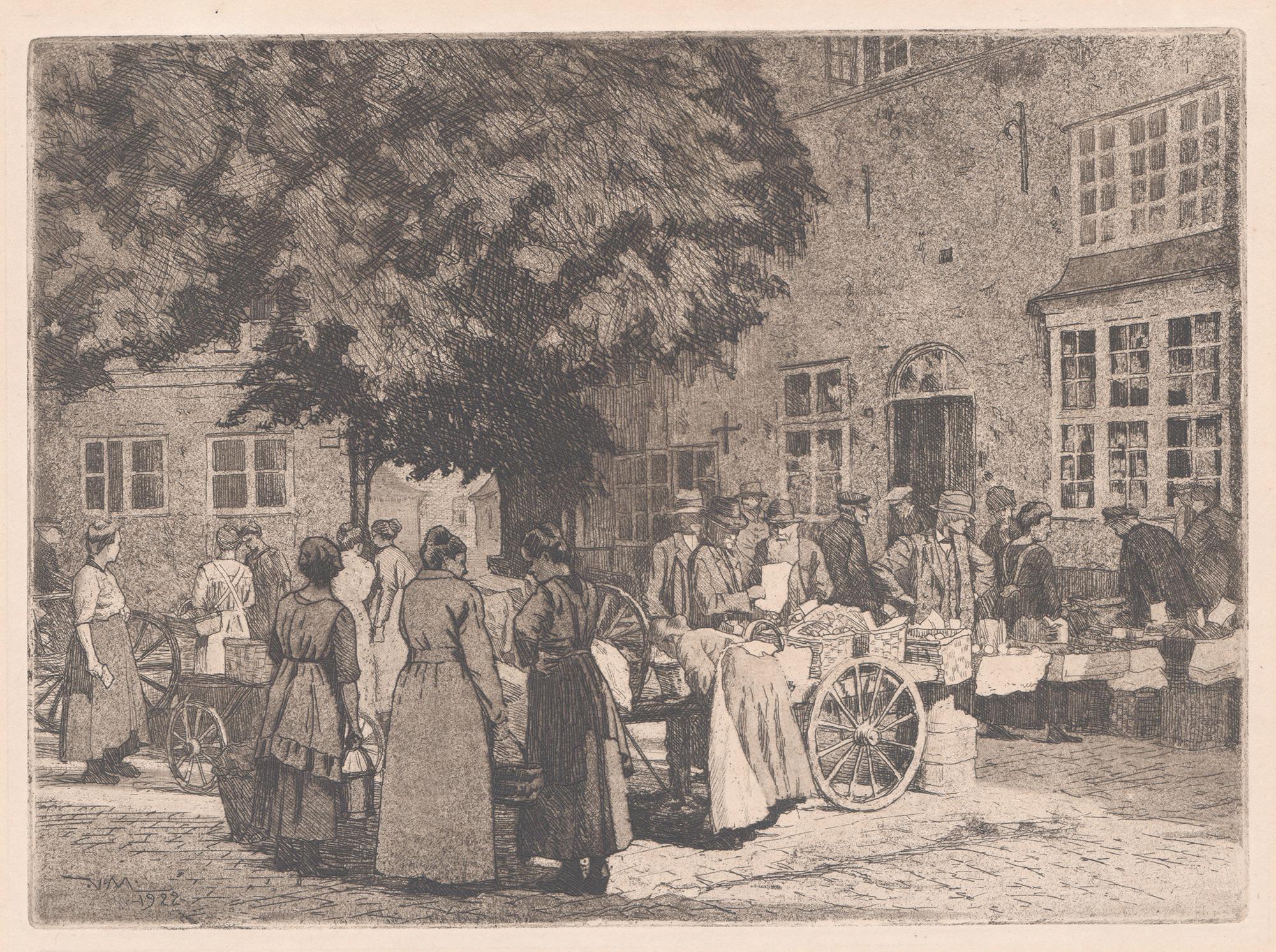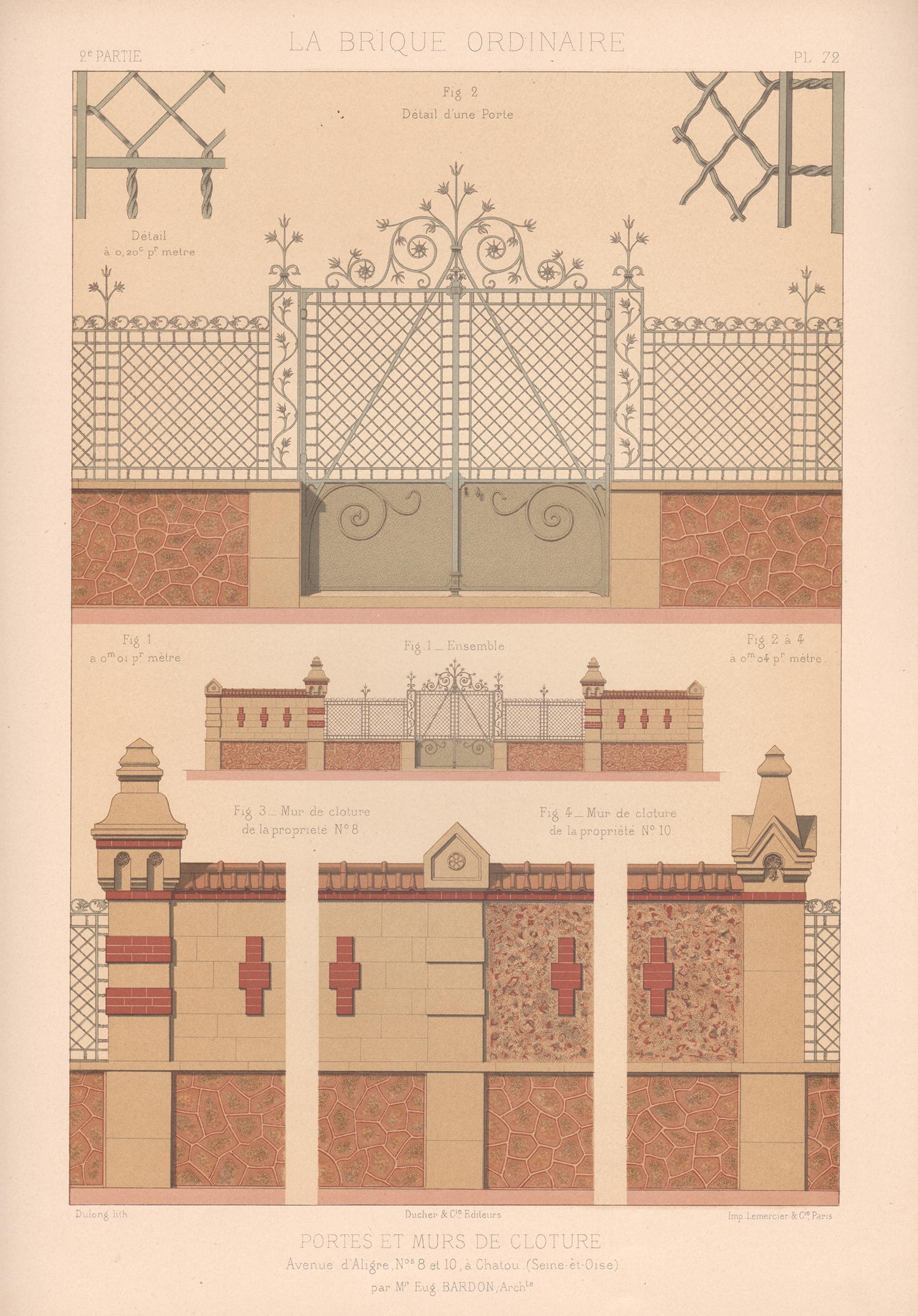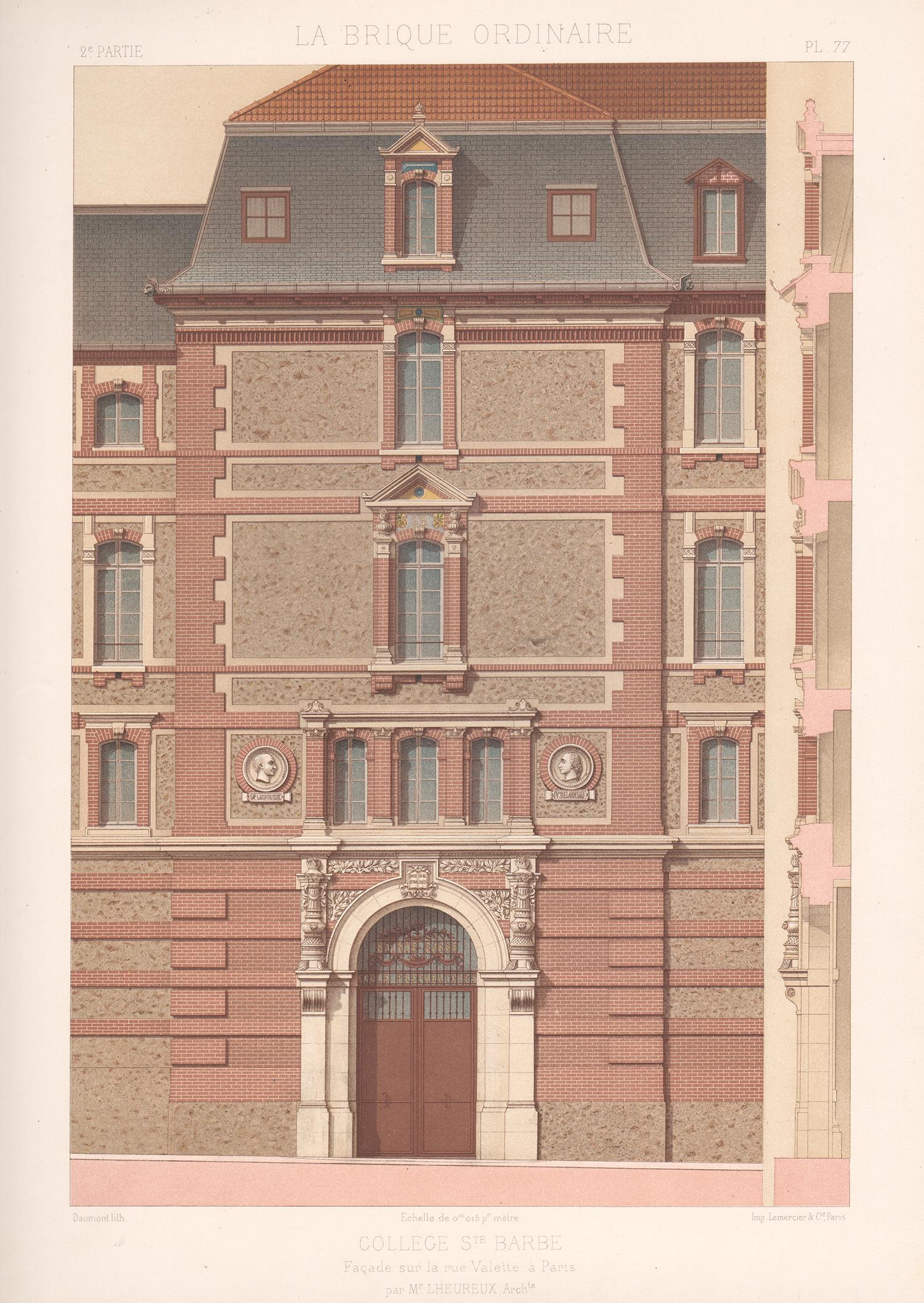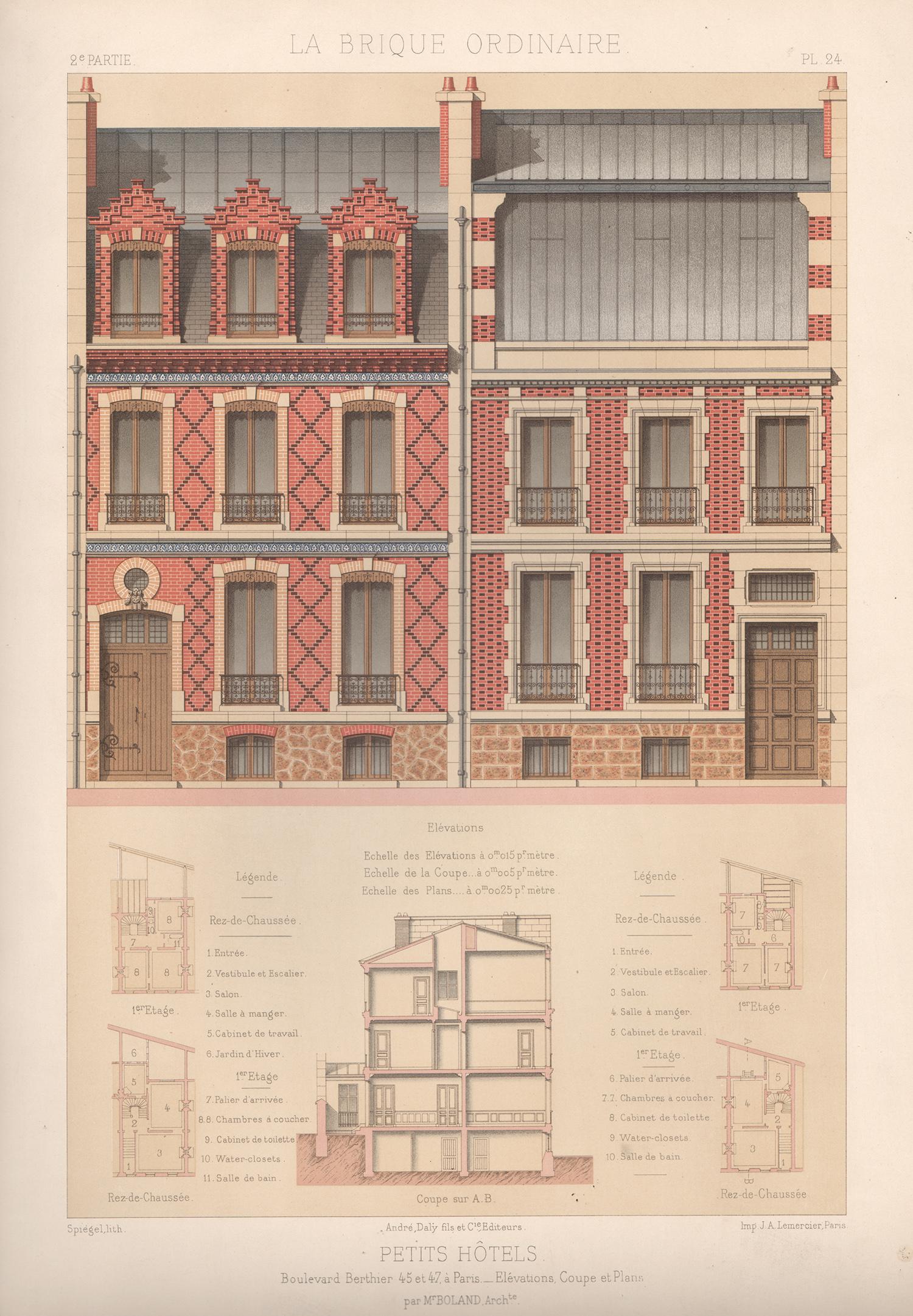Items Similar to A L'Ombre (In Shadow)
Want more images or videos?
Request additional images or videos from the seller
1 of 6
Louis LegrandA L'Ombre (In Shadow)1905
1905
About the Item
A L'Ombre (In Shadow)
Etching & drypoint, 1905
Signed with the red stamp of the publisher Pellet (see photo)
Edition: 50 on velin paper, signed and numbered
Publisher: Gustav Pellet, Paris (his red stamp lower right, recto; Lugt 1193)
Condition: Excellent
Image/Plate size: 5-7/8 x 8-5/8" (14.8 x 21.8 cm.)
Sheet size: 11 5/8 x 17 1/8"
Reference: IFF 119
Exteens 229
Arwas 256 v/V
Louis Auguste Mathieu Legrand (29 September 1863 – 1951) was a French artist, known especially for his aquatint engravings, which were sometimes erotic. He was awarded the Légion d'honneur for his work in 1906.
Life
Legrand was born in the city of Dijon in the east of France. He worked as a bank clerk before deciding to study art part-time at Dijon's Ecole des Beaux-Arts. He won the Devosge prize at the school in 1883.[2] In 1884 Legrand studied engraving under the Belgian printmaker Félicien Rops.
Legrand's artworks include etchings, graphic art and paintings. His paintings featured Parisian social life. Many were of prostitutes, dancers and bar scenes, which featured a sense of eroticism. According to the Hope Gallery, "Louis Legrand is simply one of France's finest early twentieth century masters of etching." His black and white etchings especially provide a sense of decadence; they have been compared to those of Henri de Toulouse-Lautrec, though his drawings of the Moulin Rouge, the can-can dance and the young women of Montmartre preceded Toulouse-Lautrec's paintings of similar scenes. He made over three hundred prints of the night life of Paris. They demonstrate "his remarkable powers of observation and are executed with great skill, delicacy, and an ironic sense of humor that pervades them all."
Two of his satirical artworks caused him to be tried for obscenity. The first, "Prostitution" was a symbolic drawing which depicted a naked girl being grasped by a dark monster which had the face of an old woman and claws on its hands; the second, "Naturalism", showed the French novelist Émile Zola minutely studying the thighs of a woman with a magnifying glass. Defended by his friend the lawyer Eugène Rodrigues-Henriques (1853–1928), he was found not guilty in the lower court, but was convicted in the appeal court and then given a short prison sentence for refusing to pay his fine.
Legrand was made famous by his colour illustrations for Gil Blas magazine's coverage of the can-can, with text by Rodrigues (who wrote under the pseudonym Erastene Ramiro). It was a tremendous success, with the exceptional quantity of 60,000 copies of the magazine being printed and instantly sold out in 1891.
In 1892, at the instigation of the publishing house Dentu, Legrand made a set of etchings of his Gil Blas illustrations. The etchings were published in a book, Le Cours de Danse Fin de Siecle (The End of the Century Dance Classes).
Legrand took a holiday in Brittany, which inspired him to engrave a set of fourteen lithographs of simple country life called Au Cap de la Chevre (On Goat Promontory). It was published by Gustave Pellet who became a close friend of Legrand's. Pellet eventually published a total of 300 etchings by Legrand, who was his first artist; he also published Toulouse-Lautrec and Félicien Rops among others.
He did not only work in graphics; he exhibited paintings at the Paris salon of the Société Nationale des Beaux-Arts starting in 1902. In 1906 he was made a chevalier of the Légion d'honneur.
Legrand died in obscurity in 1951. A retrospective exhibition was held at the Félicien Rops museum in Namur, Belgium in 2006 to celebrate his graphic art. The art collector Victor Arwas published a catalogue raisonné for the occasion.
Books illustrated
de Maupassant, Guy: Cinq Contes Parisiens, 1905.
Poe, Edgar Alan: Quinze Histoires d'Edgar Poe, 1897.
Awards and exhibitions
1896: First solo exhibition, Paris.
1900: Silver Medal, Universal Exhibition, Paris.
1906: Légion d'honneur.
1911: Retrospective exhibition, Palais de Modes, Paris.
2006: Retrospective exhibition, Félicien Rops museum, Namur, Belgium.
Works in collections
Joie Maternelle ("Maternal Joy"), 1900, Yale Medical Historical Library.
Titi. Brooklyn Museum.
See also
Martin van Maële
References
Louis Legrand : catalogue raisonne, Victor Arwas and the Musée Félicien Rops (Namur, Belgium), Papadakis, London, 2006
Arwas, Victor (1978). "Louis Legrand". Armstrong Fine Art. Retrieved 2013-05-10.
"Exhibit Invite #1 (etching)". Hope Gallery. 2007–2013. Retrieved 2013-05-11.
"Louis Legrand (1863-1951)". Fletcher/Copenhaver Fine Art. Retrieved 2013-05-12.
Not, as often reported, in 1902. Louis Legrand: catalogue raisonné, Victor Arwas and the Musée Félicien Rops (Namur, Belgium), Papadakis, London, 2006
Arwas, 2006.
Yale: Medical Historical Library Archived 2011-06-23 at the Wayback Machine
"Brooklyn Museum: European Art: Titi".
Bibliography
Arwas, Victor. Belle Époque: Louis Legrand. New York, 1978.
Arwas, Victor. Louis Legrand: Catalogue Raisonné. Papadakis, 2006.
Kahn, Gustave. Louis Legrand. Special issue of "L'Art et le Beau" magazine, 1908.
Mauclair, Camille. Études sur quelques artistes originaux. Louis Legrand, peintre et graveur. Paris, 1910.
Courtesy Wikipedia
- Creator:Louis Legrand (1863 - 1951, French)
- Creation Year:1905
- Dimensions:Height: 5.88 in (14.94 cm)Width: 8.63 in (21.93 cm)
- Medium:
- Movement & Style:
- Period:
- Condition:
- Gallery Location:Fairlawn, OH
- Reference Number:
Louis Legrand
Louis Legrand was born in Dijon, France, on September 29, 1863. He worked as a bank teller and studied art at the Dijon Ecole des Beaux-Arts in his spare time. At the age of 20, he won the Devosge prize at that school and a year later left for Paris. Legrand arrived in Paris in 1884, where he studied under Felicien Rops and soon became famous for his paintings, drawings and etchings depicting the Parisian beau-monde. A superb draughtsman, his etchings also show great sophistication. Legrand's prints were almost all published by Gustave Pellet, who published many erotic images.
About the Seller
5.0
Recognized Seller
These prestigious sellers are industry leaders and represent the highest echelon for item quality and design.
Platinum Seller
These expertly vetted sellers are 1stDibs' most experienced sellers and are rated highest by our customers.
Established in 1978
1stDibs seller since 2013
712 sales on 1stDibs
Typical response time: 1 hour
Associations
International Fine Print Dealers Association
- ShippingRetrieving quote...Ships From: Fairlawn, OH
- Return PolicyA return for this item may be initiated within 10 days of delivery.
More From This SellerView All
- Bloques (Road Block)By Georges MeunierLocated in Fairlawn, OHBloques (Road Block) Color lithograph, 1905 Signed and numbered in pencil lower right; signed and dated in the stone lower right (see photo) Edition: 100, first edition (33/100) Published by Edmund Sagot, Paris Printed by Atelier Chaix, Paris Deluxe edition with artist's signature and penciled edition, as well as Sagot blindstamp There is an unlimited edition with title and publisher, printer text below the image. (state ii/II) Condition: Excellent, never matted or framed Image size: 13 x 19 5/8 inches Sheet size: 18 x 24 3/4 inches Provenance: Edmund Sagot (1857-1917) publisher Sagot Heirs Georges Meunier (1869-1934) Meunier was born in Saint-Cloud, France in 1869. He moved to Paris as a young man and studied at the National School of Fine Arts; there, he was a student of artist Joseph-Robert Fleury. Following this training, Meunier attended The School for the Decorative Arts where he was trained in both classical and modern design, these skills would later influence his poster graphics. Subsequent to his education, Meunier's posters were exhibited in salons throughout Paris, giving his work notoriety. George Meunier was a prolific artist at the turn-of-the-century influenced greatly by Cheret, the founder of the advertising poster movement. Meunier succeeded Cheret at the Chaix printing house as principal artist and director. He worked as a poster artist for only a short time, making a career change to a book illustrator, which he pursued until the end of his life. Regarding the publisher Edmund Sagot (1857-1917) Edmond-Honoré Sagot , born in 1857 and died on April 6 , 1917, is a bookseller , art dealer , publisher of prints and original posters . In 1881 he founded the house “Ed. Sagot” in Paris. This establishment still exists under the name “ Sagot - Le Garrec ” and is one of the oldest art galleries still in operation. Edmond Sagot is the first contemporary art dealer...Category
Early 1900s Art Nouveau Landscape Prints
MaterialsLithograph
- Cover illustration for Die Graphischen Kunste, Volume 22By Henri RiviereLocated in Fairlawn, OHCover illustration for Die Graphischen Kunste, Volume 22 Color lithograph, 1899 Signed with the artist's initials lower center (see photo) From: The Graphic Arts, Volume 22, 1899 ...Category
1890s Art Nouveau Landscape Prints
MaterialsLithograph
- Minneapolis at DuskBy Richard HaasLocated in Fairlawn, OHMinneapolis at Dusk Etching & aquatint printed in colors, 1993 Signed, titled and numbered in pencil Edition: 65 (19/65) Condition: Excellent This image depicts the Wells Fargo Center designed by Cesar Pelli Richard Haas (American, b.1936) is a practitioner of the trompe l'oeil artistic style, a technique that uses realistic images in a way that tricks the eye into perceiving the painting in three dimensions. Haas has painted hundreds of murals that incorporate trompe l'oeil methods in the depiction of the architectural features of the building. He was born in Spring Greene but grew up in Milwaukee, WI. He graduated in 1959 from the University of Wisconsin-Milwaukee with a Bachelor in Art. Instructors for his courses included Joseph Friebert (American, 1908–2002) and Robert Von Neuman (German, 1888–1976). Haas returned to his birthplace to work as a helper for his stonemason uncle, and he had an opportunity to view the work of the architect Frank Lloyd Wright (American, 1867–1959). He spent several years as an assistant professor at the University of Michigan before he moved to New York City in 1968. Haas spent 10 years teaching at Vermont's Bennington College, splitting his time between the school and New York. Haas worked for many years as an Abstract painter who used traditional canvas media. He later developed an interest in drawing and etching the details of late 19th century and early 20th century New York City buildings. The artist’s first outdoor mural, a commission to paint the cast iron façade at the corner of Prince Street and Greene Street, was completed in 1975. His other notable murals include Fort Worth, Texas' Homage to Chisholm Trail...Category
1990s Photorealist Landscape Prints
MaterialsEtching
- La Grande Cascade de Saint CloudBy Alfredo MüllerLocated in Fairlawn, OHLa Grande Cascade de Saint Cloud Color aquatint on watermarked Arches J Perrigot paper, 1905 Signed by the artist in pencil lower right. (see photo) Edition: 100. Numbered "39" in pencil lower left. Titled in pencil verso Published by Edmund Sagot, Paris, his dry stamp lower right below signature. Image: 23-1/8 x 17-3/8" (58.7 x 44 cm.) From the British Museum: "Colour etcher. Born in Livorno from a family of wealthy Swiss cotton merchants, studied with Giuseppe Ciaranfi and Michele Gordigiani in Florence. In 1886 exhibited with Fattori, Achille Lega and Tommasi in the Prima Esposizione delle Belle Arti in Livorno. In 1888 he and his family moved to Paris, where he studied first with François Flameng until 1892 and later with Carolus-Duran. Müller remained in the French capital until the outbreak of the First World War, taking French citizenship in 1913. He worked in the countryside at Barbizon, Suresnes and elsewhere, but also made frequent visits to his native country, where he exhibited regularly in Florence with the Promotrice Fiorentine. His early work was indebted to Fattori and Plinio Nomellini, but he soon became interested in the Impressionists and was credited by the critic Mario Tinti with introducing the luminism of Monet into Italian art. Müller was a member of the Société des Artistes Indépendents and exhibited regularly in the Paris dealer George Petit's annual exhibitions of colour prints. He made his first print in 1896, a lithographic portrait of the poet Paul Verlaine in the Café Procope. The following year Müller made his first colour aquatints. Among them were a series of illustrations to Dante's Divine Comedy. In style his etchings and aquatints were influenced by Manuel Robbe. Very occasionally he combined drypoint or soft ground etching with aquatint. Müller's principal publisher was Pierrefort, who also issued prints by Toulouse-Lautrec. After 1903 he largely abandoned aquatint for pure etching. Fourteen of his colour etchings were reproduced over a number of months in the weekly magazine 'Le Courrier français'. Müller also made a small number of colour lithographs, some of which were published by the Parisian print dealer Sagot. A single monotype of Mallarmé done in 1911, thirteen years after the poet's death in 1898, is recorded. Müller made a few landscape prints and a couple of etchings of fishing boats, but his principal subject was young women in long dresses. Often there is an aura of fin-de-siècle wistfulness. When he returned to Italy, he lived first in Taormina, then in Florence, and finally settled in a villa at Settignano. Müller largely abandoned printmaking after 1914. Only three more prints by him made in 1920, 1925 and 1933 are recorded after he moved back to his native country. Müller was a regular exhibitor in Florentine exhibitions, the most significant of which was the 1922 Primaverile Fiorentina. He returned to France in 1930 where he died in 1939. (Text by Martin Hopkinson)" Said to rival the fountains at Versailles, La Grande Cascade is still turned on for a few hours every Sunday in June. The Grande Cascade, constructed in 1664-1665 by Antoine Le Pautre has survived. The château was expanded by Phillipe de France, duc d'Orléans in the 17th century, and finally enlarged by Marie Antoinette in the 1780s. Napoleon I and Napoleon III also used the palace, which was a U-shaped scheme of three sections, open to the east. Destroyed by fire (with the exception of a few outbuildings and its majestic garden) in 1870, during the Franco-Prussian War. The burned-out shell stood until 1891, when it was demolished. The gardens were replanned by André Le Nôtre...Category
Early 1900s French School Prints and Multiples
MaterialsAquatint
- Early Morning RainBy Norman AckroydLocated in Fairlawn, OHEarly Morning Rain Etching & color aquatint, 1977 Signed, titled, numbered and dated in pencil Edition: 40 (39/40) Published by Associated American Artists, New York Condition: Mint Image/Plate size: 16 1/2 x 15 3/8 inches Sheet size: 25 3/4 x 19 1/2 inches Reference: AAA Index No. 2486 "Norman Ackroyd (RA) is one of Britain’s most celebrated living landscape artists. He is renowned for his evocative and atmospheric visions of the British Isles. Working in both etching and watercolour, he is equally as adept at capturing the calm of a Summer’s daybreak as he is the ferocity of a winter sea. Born in 1938 in Leeds, he studied at Leeds College of Art (1957-61) and the Royal College of Art in London...Category
1970s Modern Landscape Prints
MaterialsAquatint
- Desolation, S.C. or Deserted Cabins, Beauford, S.C.By Louis Oscar GriffithLocated in Fairlawn, OHDesolation, S.C. or Deserted Cabins, Beauford, S.C. Etching & Aquatint, c. 1930 Signed by the artist in pencil lower right (see photo) Annotated "Trial Proof" in pencil lower left co...Category
1930s American Impressionist Landscape Prints
MaterialsAquatint
You May Also Like
- Street Market - Montmatre, France, etching, 1922Located in Melbourne, VictoriaMonogram and date of etching in the plate bottom left. 220mm by 305mm (platemark) 310mm by 390mm (sheet)Category
1920s Art Nouveau Landscape Prints
MaterialsDrypoint, Etching
- Troubadour, from The Mastersingers of NurembergLocated in Middletown, NYStipple point etching on tissue-thin handmade Japon paper, 7 5/8 x 5 inches (193 x 126 mm), full margins. Signed, titled, dated, inscribed and numbered 10/25 in pencil, lower margin....Category
Early 20th Century Jugendstil Landscape Prints
MaterialsHandmade Paper, Etching
- French architecture house design lithograph, late 19th century, 1878Located in Melbourne, Victoria'Portes et Murs De Cloture, Avenue d'Aligre, Nos 8 et 10, a Chatou (Seine et Oise), par Mr Eug. Bardon, Archte'. French architectural chromolithograph. From 'La Brique Ordinaire', b...Category
Late 19th Century Art Nouveau Landscape Prints
MaterialsLithograph
- French architecture house design lithograph, late 19th century, 1878By Jean-Francois DaumontLocated in Melbourne, Victoria'College Ste Barbe. Facade sur la rue Valette a Paris, par Mr L Heureux, Archte' French architectural chromolithograph. From 'La Brique Ordinaire', by J Lacroux, 1878. A series of ...Category
Late 19th Century Art Nouveau Landscape Prints
MaterialsLithograph
- French architecture house design lithograph, late 19th century, 1878By SpiegelLocated in Melbourne, Victoria'Petits Hotels. Boulevard Berthier 45 et 47, a Paris. Elevations, Coupe et Plans, par Mr Boland, Archte.' French architectural chromolithograph. From 'La Brique Ordinaire', by J Lac...Category
Late 19th Century Art Nouveau Landscape Prints
MaterialsLithograph
- French architecture house design lithograph, late 19th century, 1878Located in Melbourne, Victoria'Ecuries et Remises.' French architectural chromolithograph. From 'La Brique Ordinaire', by J Lacroux, 1878. A series of fine illustrations of French designs for brick buildings. ...Category
Late 19th Century Art Nouveau Landscape Prints
MaterialsLithograph






